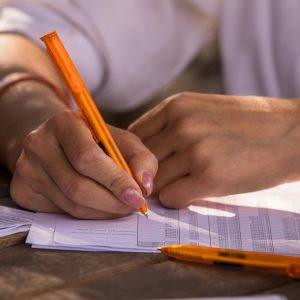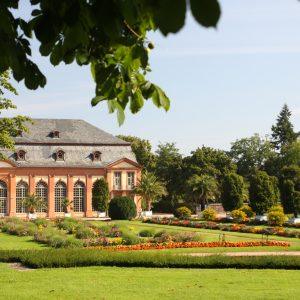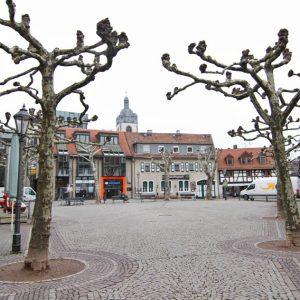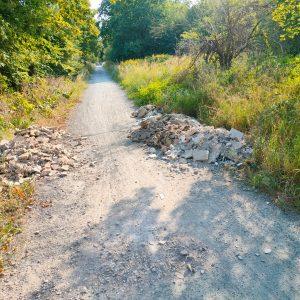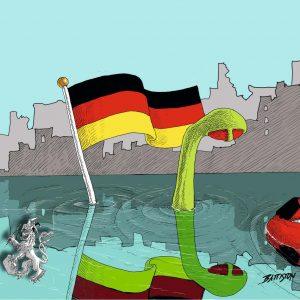A contribution by Pauline Dörrich for the project "What's going on?!" From students at the H_DA
Briefly at checkout again? Then why not improve finances with a flea market sale? But does that work too? A report from the flea market in the Dieburger Schlossgarten.
Dieburg, Friday afternoon, shortly after 3:00 p.m. There is a lot going on in the castle garden on the edge of the old town on this hot summer day. Even in less than 24 hours, the otherwise quiet place is transformed into the largest flea market in the city and becomes a real paradise for bargain hunters. Cars slowly drive over the Kieselsteinweg. Tables, benches and pavilions are unloaded from the cars around the large meadow in the park and built up for the next day. Occasionally passers -by pass by the action. Others made themselves comfortable in the shade on the park benches and watch the goings -on interested.
5:00 p.m. The first exhibitors disappeared again after the structure. The flea market is now ready for sale.
Flea market from the perspective of the circular economy
Jonas Barth, an expert in circular economy at the Institute for Production Management, Technology and Machine Tools in Darmstadt, finds the concept of flea markets positively: “From a circulatory business perspective, flea markets are the prime example of bringing used goods to the man or to the woman and thereby creating further benefits. Because the resale of products is not only resource Co2 footprint is also to be passed on economically efficiently than you have to do.
Flödel, meeting point and tradition
The Junge Union Darmstadt-Dieburg has been organizing the flea market in the Dieburger Schlossgarten for almost thirty years. He is known for his colorful and diverse offer. It is possible to set up a sales stand on Friday to 5:45 a.m. on Saturday. A prior registration is not required. The stand fees vary depending on the size. In general, a price of four euros per square meter applies. There is also a garbage of ten euros. The market from 6:00 a.m. to 1:00 p.m. for potential buyers: open inside.
The bargain hunt can begin
Saturday morning, 9:00 a.m. At one of the many stands, Vicky, a young woman in his mid -twenties, is together with her boyfriend: inside Jack and Vanessa. For them, the flea market started much earlier. At 5:45 a.m. to be precise. "I hardly slept tonight," reveals Vicky a little tired. "Maybe an hour." Nevertheless, the mood at your stand is good. Relaxed music sounds from a music box. The first buyers: inside is already there and use the cool morning hours to stroll over the market relaxed and without crowds.

Vicky sells clothes, kitchen items, a large selection of books and CDs, jewelry, cosmetic items and a very well-preserved Nikon reflex camera. Expert Jonas Barth thinks the product range from Vicky is good: "Products that are suitable for a flea market sale, for example, are clothes, all in the field of textiles. Then bicycles are absolutely predestined. I recently sold a bike via small ads. Furniture in general, i.e. furniture and tables.

Vicky is friendly and open to her announcement: inside. It calls the price for the respective product and comes into conversation with interested parties. You can pay either bar or via PayPal-QR code. She learned how to deal with the customers at a fast fashion company. There she worked as a seller and received discounts on her purchases. "There is a lot going on," she says. For the expert Jonas Barth, Vicky, as a flea market seller, is a good example of a functioning circular economy. Because she understood a crucial point. Barth wants society to aware of which resources are used, as well as the willingness to compromise on some things. "By that I don't even mean that less should be consumed or you should restrict more, but that you can see where the products come from and to what extent they can be passed on. In this respect: sell instead of throwing away."
In the middle of wild negotiations
Vicky is on flea markets out of pure passion. To do this, she likes to get up early. "I am not concerned with taking up a lot of money. I want things to continue to be worn and use and you can find happy buyers: it would be nice if I would at least have the stand fees in the end of the day. However, I don't have a certain amount that I would like to take today." Just not today.
For Vicky girlfriend Vanessa it is the first sale at the flea market, but the sale itself is nothing unknown to her. She works in a Duty-Free shop at Frankfurt Airport. Your sales strategy: You offer a small free product for every article sold, such as hair tie, magnets or key rings. Barth finds flea markets very promising for private sale: "In my view, flea markets have the advantage that you have a platform. People just come over and look around. So you don't have to make extra advertising to win customers and is often cheaper than new."
Vicky sells her clothes for one to two euros each. With one of her pockets, she has the exact price in her head. It is a brand pocket that she once bought for a lot of money. She would like to have 30 euros for that. A young girl with a white dress and blond hair is interested in the bag. She wants to buy it for 20 euros. Vicky is clearly too little. The two negotiate and finally agree. "I am a bit sad that I sold the bag for 23 euros. I had hoped for a lot more. But I had also had it in Vinted for some time for 50 euros and now I'm also glad that I sold it."

Negotiations are also made to the SLR camera. A young man asks: "What do you want for it?" "220 euros," replies Vicky. "It is really good in the shot, with all accessories and very rarely used." She rejects a counter offer of 120 euros with a smile. "Cheeky negotiation commandments occur again and again. It is important to stay persistent. My mother gave me that from the start."
A lot of going out for long fingers
People stand almost continuously on Vickys, which an older lady takes advantage of. Just when Vicky is deepened into a sales talk, the woman gets one of her blouses without paying her and leaves the stand without a word. Before Vicky notices it, the woman is up and of it. For Vicky, however, this is nothing new: "My mother taught me to just exhibit a shoe for shoes to avoid possible theft. It is not about that I could not take anything with the article, but about the principle." For Barth, dark sides are also a non -transparent economic output. "The money goes over the table without an invoice and it is difficult to understand. In addition, the sale from private to private takes place, which means that there is no guarantee and the quality is not checked."

It is 12:30 p.m. The sun is now vertically in the sky. The heat can hardly be endured. In the meantime there is also Vickys stand in the blazing sun. The sales flow gradually lowers. The first stalls are broken down. About 15 minutes before the end, Vicky also begins to stow her goods in transparent plastic boxes. Your handles sit. "It's over again that quickly," says Vicky and breathes deeply. "Next time I'm on the flea market in Schaafheim and the following week in Bad König."
The cash fall
1:00 p.m. The flea market is over. What does the cash register say? Vicky has taken around 35 euros including the stand fees. "I have already taken 300 euros on good days, but the flea market went much longer. So it is always a surprise which sum comes together at the end of a flea market day."
This article was made as part of the project "What's going on" - a teaching editorial team of students from the online journalism course at the Darmstadt University of Applied Sciences (H_DA). Da.news supports the project and publishes selected articles on its platform. Further information and texts are available here and on: www.was-da-los.de

